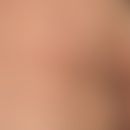Synonym(s)
DefinitionThis section has been translated automatically.
In the broader sense of general pathology: inflammation of the skin.
In the strict sense: Acute to chronic, inflammatory, non-infectious intolerance reaction of the epidermis and corium, caused by a multitude of exogenous noxae and endogenous reaction factors.
In Anglo-American usage, eczema is increasingly replaced by dermatitis.
A distinction is made between acute dermatitis and chronic dermatitis.
The classification is often based on a wide variety of criteria, e.g. appearance, localisation, age or aetiology.
ClinicThis section has been translated automatically.
- Initial redness: stage erythematosus.
- Formation of small nodules: stage papulosum.
- Formation of vesicles: stage vesiculosum.
- Bursting of vesicles: stage madidans.
- Crusting of the weeping surfaces: stage crustosum.
- Desquamation: stage squamosum.
- Residual reddening: resterythema.
- Healing: Restitutio ad integrum.
You might also be interested in
HistologyThis section has been translated automatically.
According to a scheme varied by Ackerman, 8 different fabric patterns can be defined. These differ in
- their topographic pattern (superficial/deep)
- their relationship to the surface epithelium and skin appendages
- their relationship to the supplying structures (perivascular; perineural)
- its infiltrate composition (granulocytic/lympho-plasmocytic/epitheloid).
Depending on the location, arrangement and composition of the infiltrate in the dermis and epidermis, a distinction is made between:
- Superficial, perivascular/interstitial dermatitis
- Superficial and deep perivascular/interstitial dermatitis
- Nodular dermatitis
- Diffuse dermatitis
- Subepidermal, vesicular dermatitis
- Folliculitis and perifolliculitis
- Fibrosing dermatitis
- Vasculitis (small and large vessel).
Since the epithelial inflammatory response is often of groundbreaking importance for the histological diagnosis, the reaction patterns of the epithelium are additionally classified in the histological diagnosis. Basically the following 3 reaction types (R) are distinguished, which are also transferable to the clinical-morphological area:
- R1 spongiotic-vesicular (eczematous dermatitis)
- R2 psoriasiform (psoriasiform dermatitis)
- R3 lichenoid (lichenoid dermatitis).
The spongiotic vesicular reaction is distinguished according to the type of vesiculation and its localization:
- Vesiculation type (V):
- V1 spongiotic
- V2 Ballooned
- V3 acantholytic.
- Localization (L):
- L1 suprabasal
- L2 intraspinal
- L3 subcorneal.
Differential diagnosisThis section has been translated automatically.
TherapyThis section has been translated automatically.
Elimination of the triggering noxious agents, phase-appropriate therapy according to the prevailing clinical findings. In the case of chronic dermatitis in particular, test ointment tolerance as quickly as possible (epicutaneous test, lobule test, quadrant test). Select suitable or preferably indifferent bases (e.g. aqueous solutions, Vaselinum alb.). In particular, no wool waxes and wool wax alcohols! If glucocorticoid sensitization is suspected, use 0.1% mometasone (e.g. Ecural ointment, fat cream, solution) if necessary, as no cross-allergies have yet been described.
- Acute dermatitis
: Remember! Basic principle: The more acute and weeping the dermatitis, the more watery the base!
Acute vesicular to bullous stage (weeping): Short-term glucocorticoids of medium to strong potency such as 0.1% triamcinolone (e.g. Triamgalen, R259 ), 0.25% prednicarbate (e.g. Dermatop cream/ointment), 0.1% mometasone (e.g. Ecural fat cream, ointment) or 0.05% clobetasol (e.g. R054, Dermoxin cream/ointment) depending on the clinic and localization. No isolated application of greasy bases, but rather solutions or hydrophilic creams such as Ungt. emulsif. aq. (e.g. R259, R054, Dermatop cream, Ecural Lsg.). If an oily base is used, then in combination with moist compresses; moist compresses are also indicated in combination with hydrophilic creams. Envelopes with e.g. Ringer's solution, in the case of superinfection with antiseptic additives such as quinolinol (e.g. Quinosol 1:1000), octenidine, R042 or potassium permanganate (light pink).
In the vesicular stage also greasy-moist with glucocorticoid such as 1% hydrocortisone in a lipophilic base such as Vaselinum alb.(hydrocortisone ointment 1%), with a moistened verba)d (e.g. Ringer's solution) or a cotton glove if necessaryCaution! Restrained use of glucocorticoids on sensitive skin areas such as face, neck, intertrigines (submammary, groin region, ano-genital area)!
Crusty or squamous stage: Hydrophilic creams with the highest possible fat content to regenerate the skin (e.g. base cream (DAC), Linola cream, Asche base cream, Excipial cream, Eucerin, Dermatop base cream). If necessary, also with wound-healing additives such as dexpanthenol (e.g. R064, Bepanthen ointment).
Follow-up treatment: Nourishing, moisturizing topical products with a compatible base (e.g. Linola Fat N, Ash Base Ointment, Excipial Almond Oil Ointment), if necessary with the addition of 2-10% urea (e.g. R102, R107, Basodexan Cream, Excipial U Lipolotio, Eucerin 10% Urea Lotio). - Chronic dermatitis
: Remember! Basic principle: The more chronic the dermatitis, the greasier the base! Short-term glucocorticoids of medium to high potency, see above, in a greasy base (e.g. Ecural fat cream, Dermatop ointment). Then antiphlogistic topicals such as Pix lithanthracis. Try Pix lithanthracis 2% in zinc oil (coal tar zinc oil 2-5%) or external agents containing coal distillate or shale oil sulphonate (e.g. Ichthosin, Ichthoderm, tar-linola fat). Note: Currently no active agents for coal tar are available as formulation substances so that the preparations cannot be made. Alternatives are mandatory!
- Soaps and detergents should be omitted, instead oil-containing baths (e.g. Balneum Hermal, Balneum Hermal Plus, Balmandol, Linola Fat-Oil Bath), if necessary also tar-containing oil baths such as Ichtho-Bath.
- For chronic hyperkeratotic and severely scaling plaque-like dermatitis lesions (see below eczema, hyperkeratotic-rhagadiform hand and foot eczema), highly potent glucocorticoids possibly under occlusion such as clobetasol propionate (Dermoxin)
.cave! Glucocorticoids in childhood! No treatment under occlusion!
From the subacute stage of dermatitis, a combination of external therapy with UV therapy is recommended. Caution! Phototoxic and photoallergic dermatitis! High-dose UVA1 treatment has proven successful in dermatitis therapy, as has the combination of brine baths with subsequent UVB irradiation. If therapy fails, PUVA bath therapy localized to the lesion is recommended.
Internal therapyThis section has been translated automatically.
LiteratureThis section has been translated automatically.
- Ackerman AB (1997) Histologic diagnosis of inflammatory skin diseases. Williams & Wilkins, S. 111-143
- Böcker KH (1992) Eczema Diseases: Aetiopathogenetic classification as a basis for rational therapy and documentation. German Dermatol 40: 1020-1027
- Braun-Falco M et al (2003) Palmoplantar vesicular lesions in childhood. dermatologist 54: 156-159
- Diepgen TL (2003) Occupational skin-disease data in Europe. Int Arch Occupation Environ Health 76: 331-338
- Eichenfield LF et al (2003) Consensus conference on pediatric atopic dermatitis. J Am Acad Dermatol 49: 1088-1095
- Gupta AK et al (2003) Seborrheic dermatitis. Dermatol Clin 21: 401-412
- Hugel H (2002) Histological diagnosis of inflammatory skin diseases. Use of a simple algorithm and modern diagnostic methods. Pathologist 23: 20-37
- Phelps RG et al (2003) The varieties of "eczema": clinicopathologic correlation. Clin Dermatol 21: 95-100
- Schubert C (2002) Inflammatory skin diseases. An assortment of clinically relevant disease conditions. Pathologist 23: 9-19
Incoming links (29)
Amcinonide; Anal dermatitis cumulative toxic; Anal eczema contact allergic; Atopic anal dermatitis; Chromosome 18p syndrome; Clobetasol propionate cream hydrophilic 0.05% (nrf 11.76.); Coal tar-zinc oil 2-5%; Cold wave dermatitis; Cristalline miliaria; Dermatitis artefacta; ... Show allOutgoing links (27)
Antihistamines, systemic; Bubble; Cephalosporins; Clobetasol-17-propionate; Clobetasol propionate cream hydrophilic 0.05% (nrf 11.76.); Coal tar-zinc oil 2-5%; Creams hydrophilic; Desloratadine; Dexpanthenol cream hydrophilic 5% (nrf 11.28.); Dimetinden; ... Show allDisclaimer
Please ask your physician for a reliable diagnosis. This website is only meant as a reference.


























